New Method to Analyse the Cement Sheath Integrity During the Volume Fracturing of Shale Gas
Abstract
:1. Introduction
2. The FEM Model of the Casing-Cement Sheath-Formation in Shale Formation
2.1. Anisotropic Elastic Constitutive Model of Bedding Shale
2.2. The Traditional Model of CCFS
- (1)
- The casing, cement sheath and formation are all homogeneous isotropic materials;
- (2)
- The casing, cement sheath and formation are completely cemented;
- (3)
- No initial stress exists in the cement sheath;
2.3. The Staged FEM Method
- As a first step, apply far-field stress and pore pressure to the formation, then the stress field is balanced.
- As a second step, drilling is simulated, and drilling fluid column pressure is imposed on the borehole wall to simulate the wellbore deformation and stress state during the drilling process.
- As a third step, cement sheath and casing are added simultaneously to the model, then the outer cement sheath boundary matches exactly with the deformed borehole.
- As a fourth step, pressure load is applied on the interior wall of the casing to simulate the downhole condition changes during the subsequent operations. The interface of cement sheath is simulated with the interface elements-based on the Coulomb friction model.
2.4. Failure Criterion of Cement Sheath
2.5. Model Verification
- (1)
- Calculation of formation radius:
- (2)
- Stress distribution and displacement change of assembly after cementing
- (3)
- Stress distribution of CCFS during hydraulic fracturing
- (1)
- The casing, cement sheath and formation are all homogeneous isotropic materials;
- (2)
- The casing, cement sheath and formation are completely cemented;
3. Case Study
3.1. Effect of Temperature Variation
3.2. Effect of Internal Pressure Variation
3.3. Effect of In-Situ Stress on the Stress of Perforated Casing
3.4. Effect of Pore Pressure
3.5. Effect of Formation Properties
3.6. Effects of Cement Properties
4. Conclusions
- (1)
- The internal casing pressure is rather high during fracturing, and the inner wall of cement sheath is subjected to tensile stress. Volume fracturing will greatly change the temperature of casing and cement sheath. The increase of fracturing fluid temperature and control of flow rate in the fracturing process can reduce the downhole temperature difference, which is conducive to reducing the temperature stress effect on the hoop stress of cement sheaths for shale gas wells.
- (2)
- Substantial formation of fractures and fracturing fluid infiltration into the formation during the multi-stage fracturing process will lead to changes in the geostress, pore pressure and formation property around the wellbore. The risk of cement sheath tensile failure is increased in the stress deficit zones and the pore pressure build-up zones. With the decreasing mechanical properties of formation in the fracturing process, the risk of cement sheath tensile failure is reduced to some extent.
- (3)
- The elastic modulus of cement sheath has a great effect on its structure. In the site construction, an appropriate reduction of cement sheath elastic modulus and optimization of cementing quality can markedly reduce the risk of cement sheath tensile failure.
Acknowledgments
Author Contributions
Conflicts of Interest
Nomenclature
| D−1 | Elastic flexibility matrix |
| Ec | Elastic modulus of the cement, GPa |
| Ef | Elastic modulus of formation, GPa |
| Es | Elastic modulus of casing, GPa |
| p | Horizontal stress, MPa |
| pci | Initial stress of cement sheath, MPa |
| pmi | Internal casing pressure, MPa |
| pi | Hydrostatic pressure during cementing, MPa |
| q | Vertical stress, MPa |
| rf | Outer radius of formation, m |
| rs1 | Original inner radius of casing, m |
| rs2 | Original outer radius of casing, m |
| rs2’ | Outer radius of deformation casing, m |
| rw0 | Inner radius of wellbore after inner rock excavated, m |
| rw1 | Inner radius of wellbore after cementing, m |
| rwc | Radius of wellbore during drilling, m |
| ucl | Inner radius of cement sheath, m |
| uc2 | Outer radius of cement sheath, m |
| ur | Radius of wellbore during drilling, m |
| us | Outer radius variation of casing, m |
| us2 | Outer radius of casing, m |
| uw1 | Radius of wellbore, m |
| vc | Poisson’s ratio of the cement |
| vf | Poisson’s ratio of formation |
| vs | Poisson’s ratio of casing |
| Greek symbols | |
| σ’ | Stress tensor |
| σh | Minimum horizontal principal stress, MPa |
| σv | Overburden pressure, MPa |
| ε’ | Solid strain tensor |
| α | constant term |
| β | constant term |
References
- Tian, Z.; Shi, L.; Qiao, L. Research of and Countermeasure for Wellbore Integrity of Shale Gas Horizontal Well. Nat. Gas Ind. 2015, 35, 70–76. [Google Scholar]
- Jackson, P.B.; Murphey, C.E. Effect of Casing Pressure on Gas Flow through a Sheath of Set Cement. In Proceedings of the SPE Drilling Conference, Amsterdam, The Netherlands, 22–25 February 1993. SPE 25698. [Google Scholar]
- Goodwin, K.J.; Crook, R.J. Cement Sheath Stress Failure. SPE Drill. Eng. 1992, 7, 291–296. [Google Scholar] [CrossRef]
- Albawi, A.; De Andrade, J.; Torsæter, M.; Stroisz, A.; Vrålstad, T. Experimental Set-Up for Testing Cement Sheath Integrity. In Proceedings of the OTC Arctic Technology Conference, Houston, TX, USA, 10–12 February 2014. OTC-24587. [Google Scholar]
- McDaniel, J.; Watters, L.; Shadravan, A. Cement Sheath Durability: Increasing Cement Sheath Integrity to Reduce Gas Migration in the Marcellus Shale Play. In Proceedings of the SPE Hydraulic Fracturing Technology Conference, Woodlands, TX, USA, 4–6 February 2014. SPE 168650. [Google Scholar]
- Bui, B.T.; Tutuncu, A.N. Modeling the Failure of Cement Sheath in Anisotropic Stress Field. In Proceedings of the SPE Unconventional Resources Conference, Calgary, AB, Canada, 5–7 November 2013. SPE-167178. [Google Scholar]
- Dai, Q. Analysis of Production Casing Damage Reasons during Testing and Completion of Shale Gas Well. Drill. Prod. Technol. 2015, 38, 22–25. [Google Scholar]
- Sugden, C.; Ring, G.A.; Chambers, M.R.; Suryanarayana, P.V. Special Considerations in the Design Optimization of High Rate, Multistage Fractured Shale Wells. In Proceedings of the SPE Drilling Conference and Exhibition, San Diego, CA, USA, 6–8 March 2012. SPE 151470. [Google Scholar]
- Batugin, S.A.; Nirenburg, R.K. Approximate Relation between the Elastic Constants of Anisotropic Rocks and the Anisotropy Parameters. J. Min. Sci. 1972, 8, 5–9. [Google Scholar] [CrossRef]
- Yin, Y.; Chen, C.; Li, P. Theoretical Solutions of Stress Distribution in Casing-cement and Stratum System. Chin. J. Theor. Appl. Mech. 2006, 38, 835–842. [Google Scholar]
- Li, M.; Liu, G.; Li, J.; Zhang, T.; He, M. Thermal performance analysis of drilling horizontal wells in high temperature formations. Appl. Therm. Eng. 2015, 78, 217–227. [Google Scholar] [CrossRef]
- Liu, Z.; Li, H.; Liu, K.; Yu, H.; Cheng, K. Design of high-performance water-in-glass evacuated tube solar water heaters by a high-throughput screening based on machine learning: A combined modeling and experimental study. Sol. Energy 2017, 142, 61–67. [Google Scholar] [CrossRef]
- Liu, Z.; Xu, W.; Zhai, X.; Qian, C.; Chen, X. Feasibility and performance study of the hybrid ground-source heat pump system for one office building in Chinese heating dominated areas. Renew. Energy 2017, 101, 1131–1140. [Google Scholar] [CrossRef]
- Lian, Z.; Yu, H.; Lin, T.; Guo, J. A study on casing deformation failure during multi-stage hydraulic fracturing for the stimulated reservoir volume of horizontal shale wells. J. Nat. Gas Sci. Eng. 2015, 23, 538–546. [Google Scholar] [CrossRef]
- Tian, F. Elasticity Modulus and Fracture Density in the Rocks with Crevices. Acta Geol. Sin. 2007, 81, 1338–1344. [Google Scholar]
- Tao, Q.; Ding, S.; Liu, W. Study on cementing slurry system in shale gas well. China Pet. Mach. 2011, 39, 17–19. [Google Scholar]
- Tao, Q.; Chen, X. Causal analysis and countermeasures on B sustained casing pressure of shale-gas horizontal wells in the Sichuan Basin. Oil Drill. Prod. Technol. 2017, 39, 588–593. [Google Scholar]

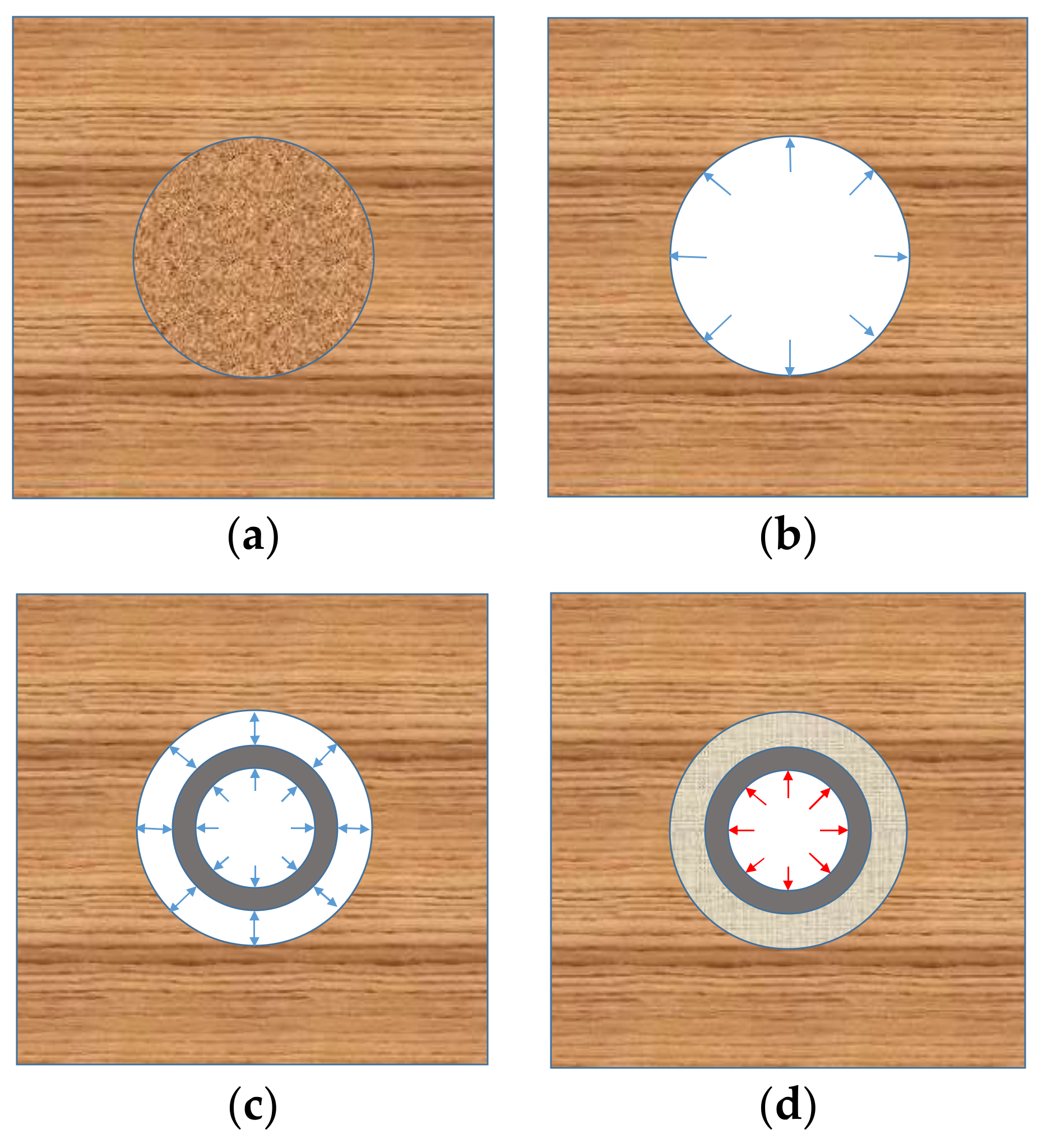
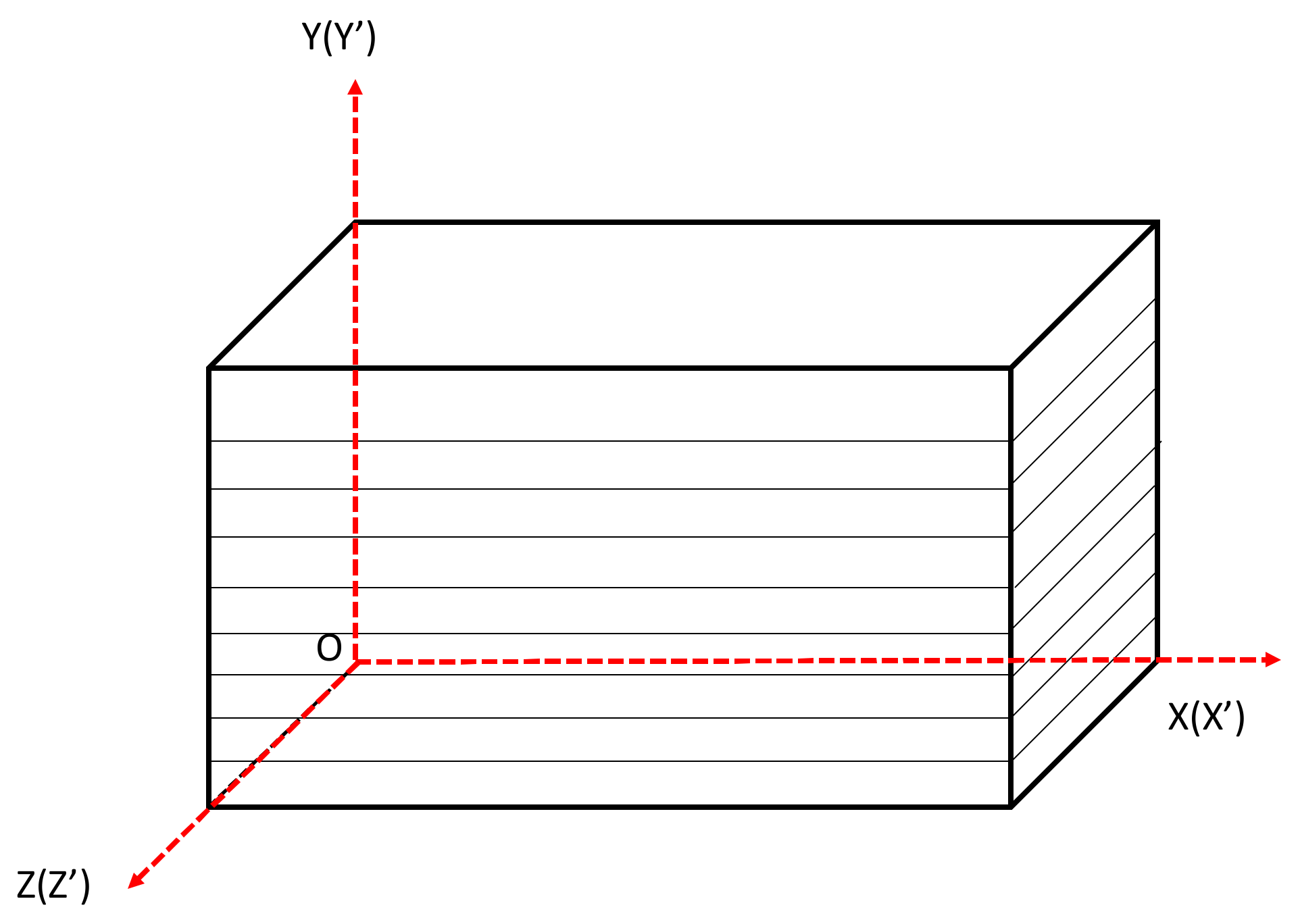
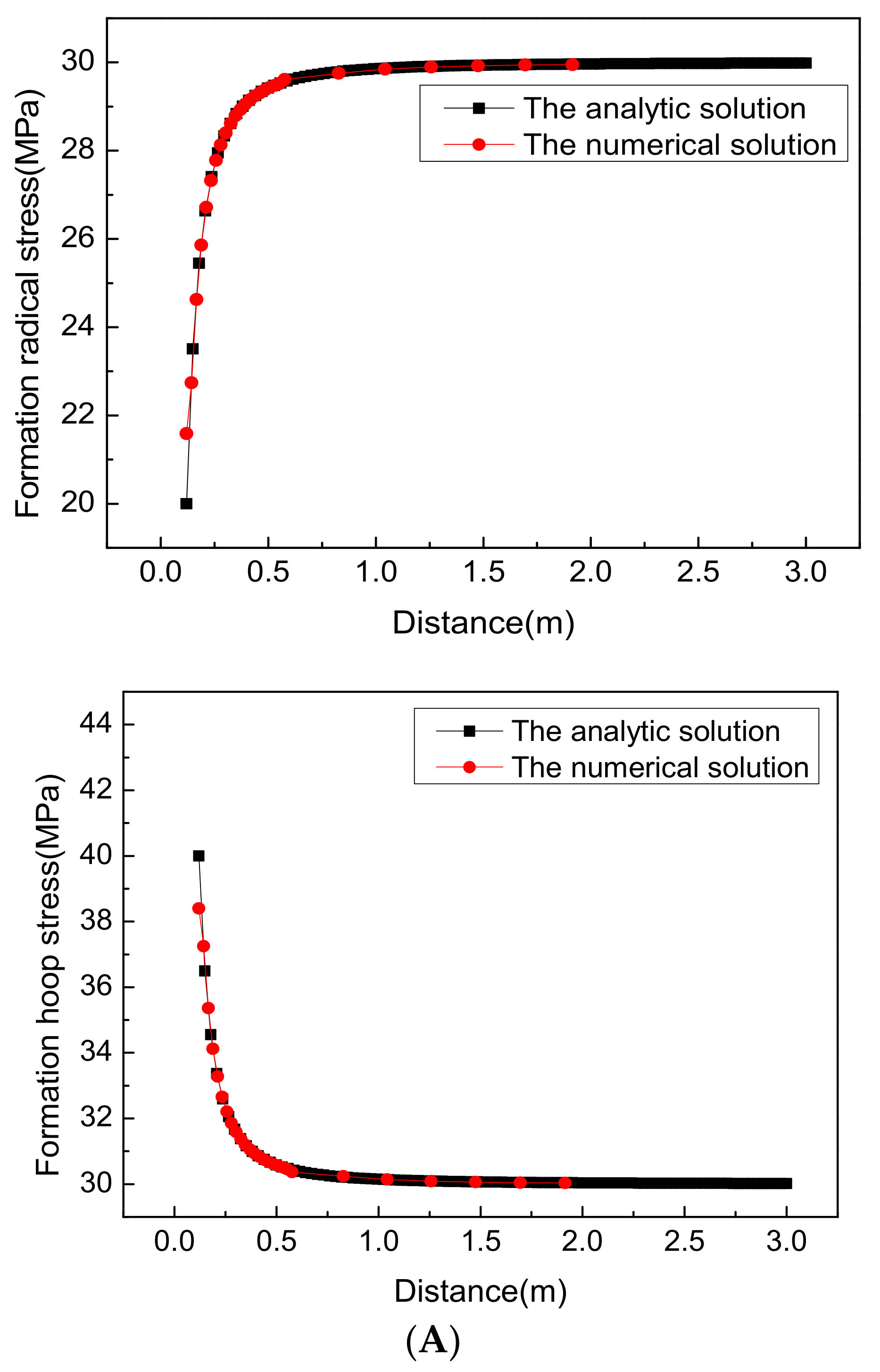

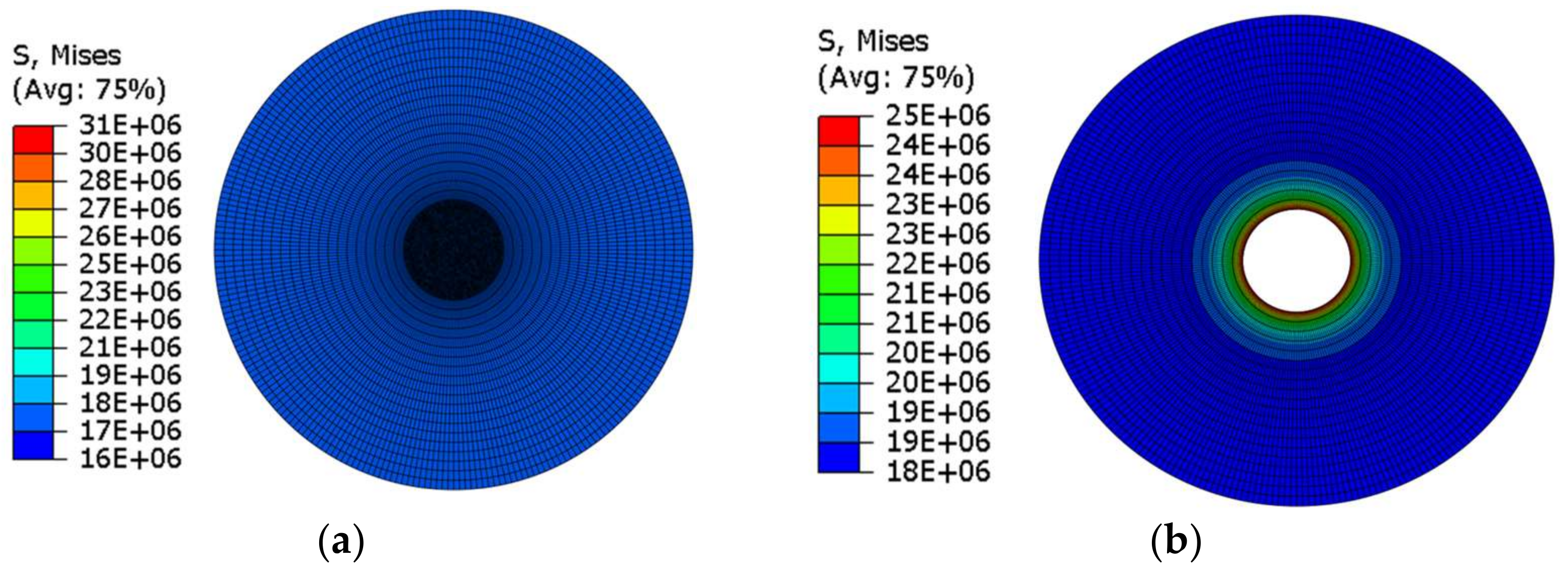

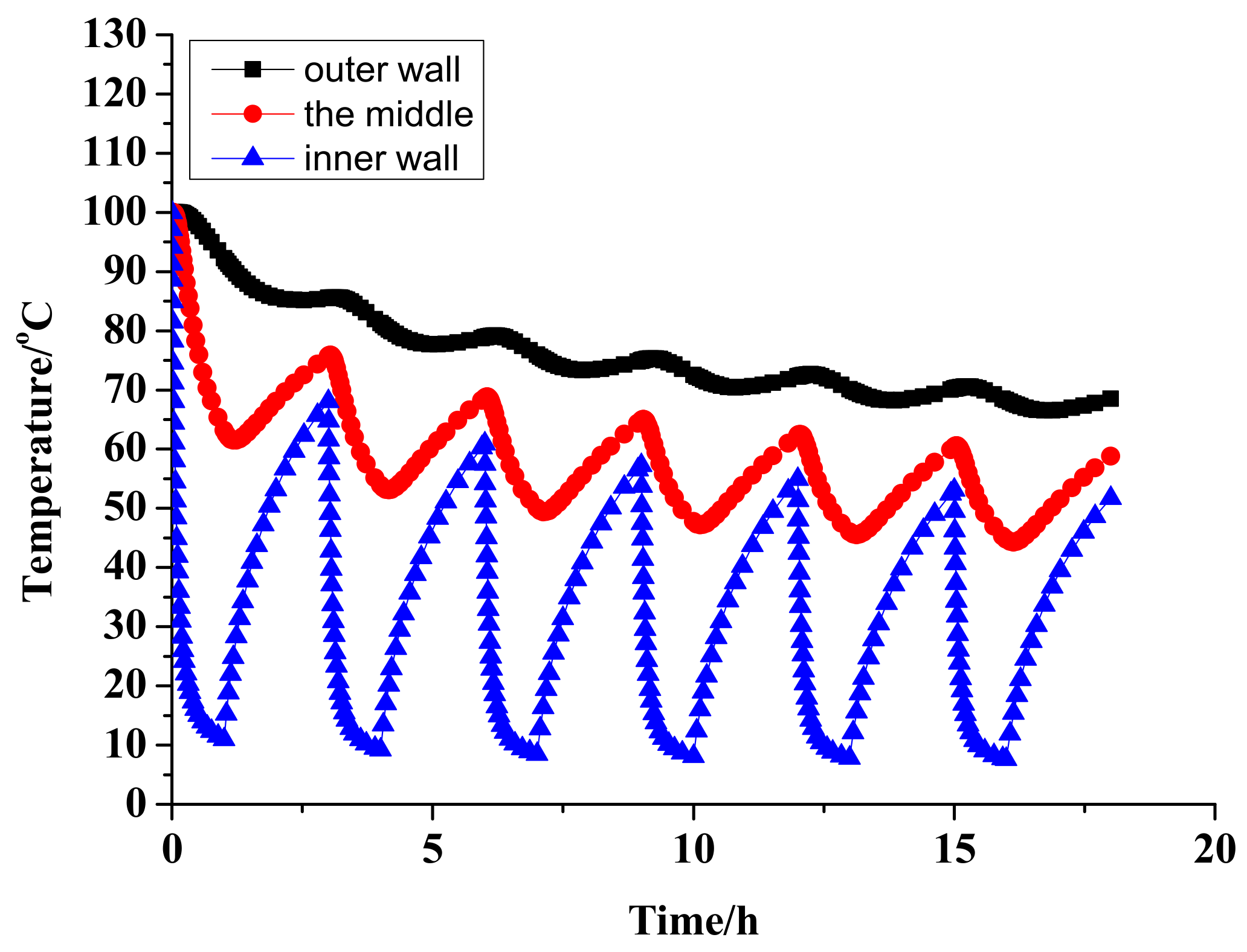
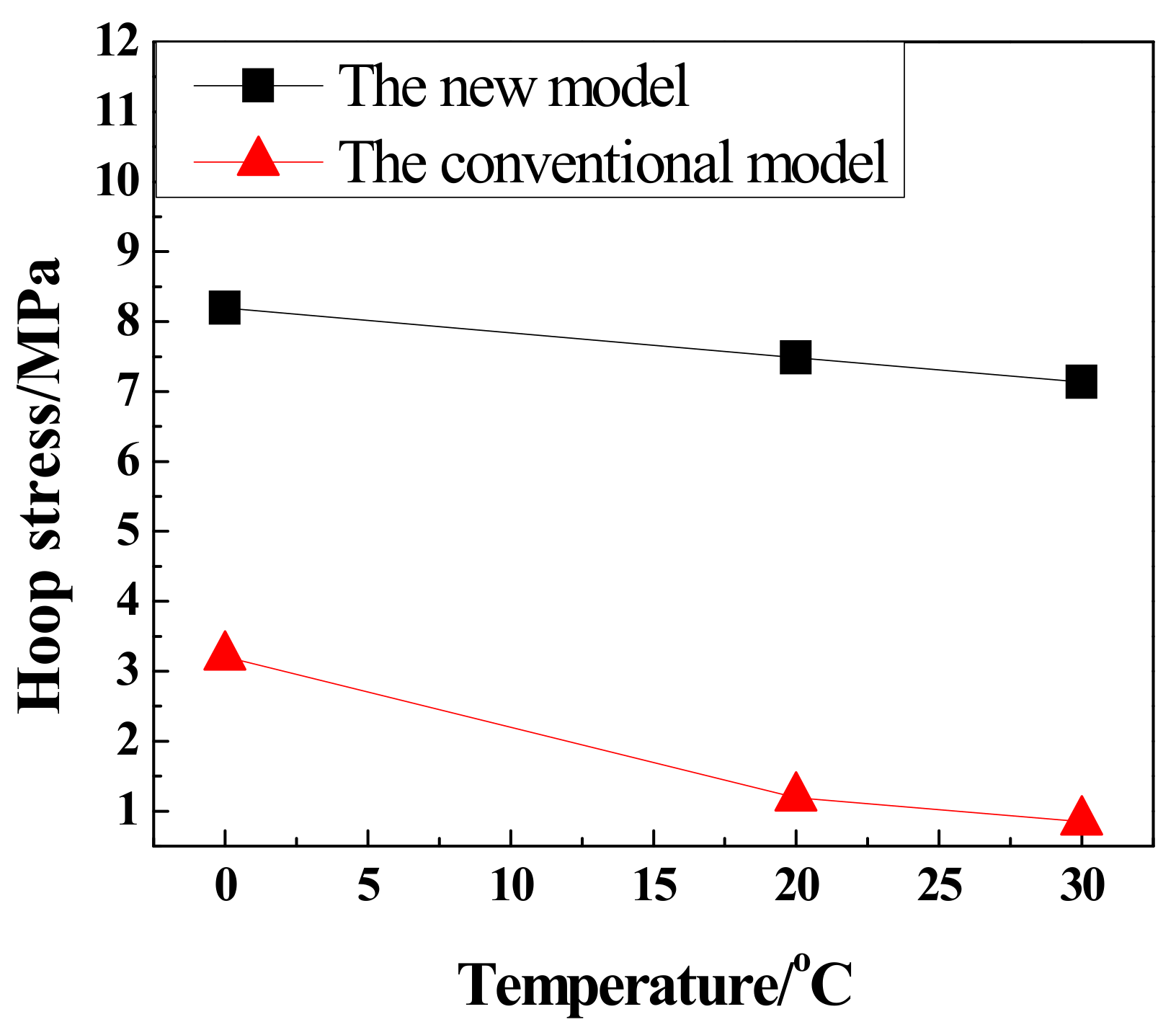
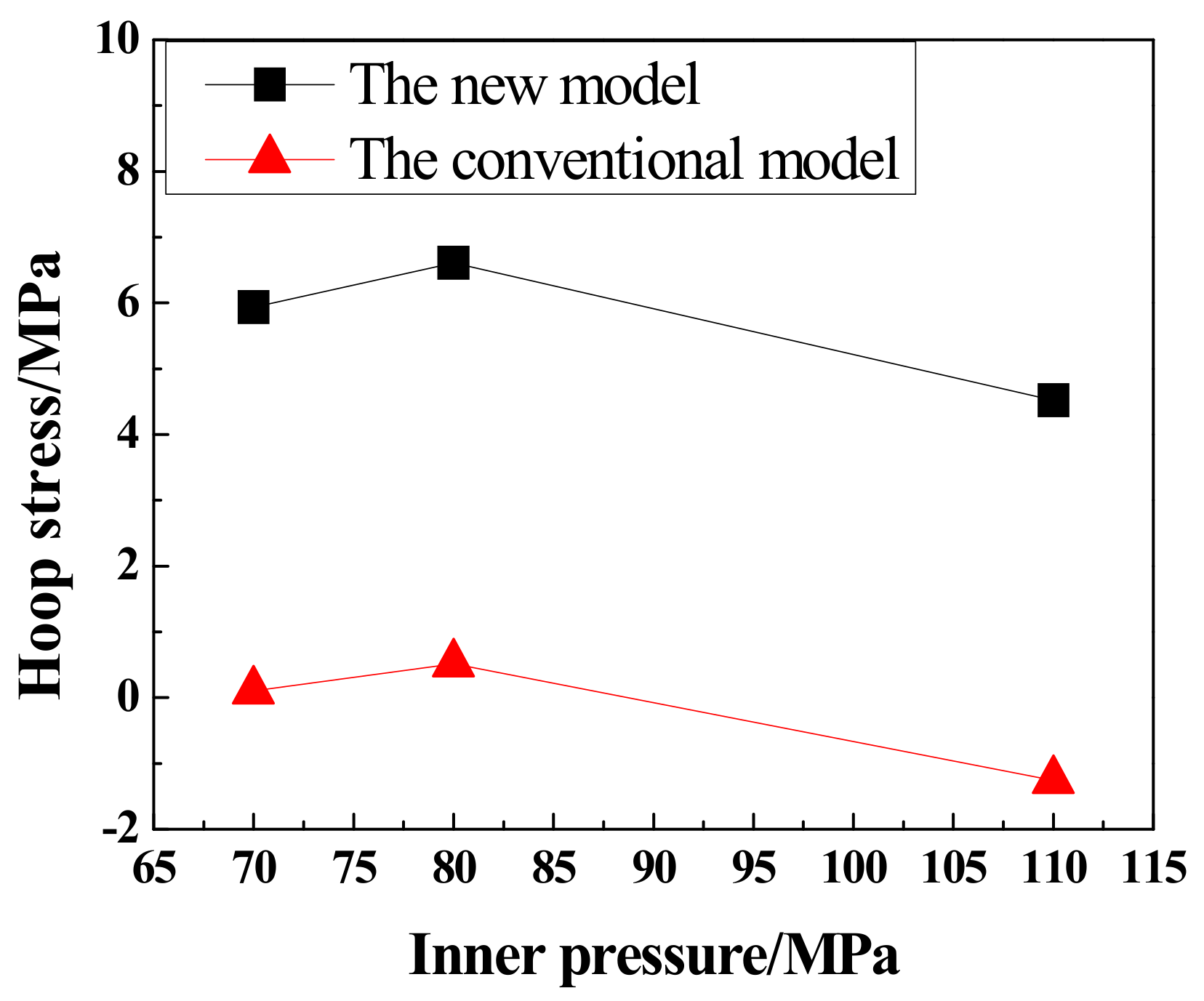
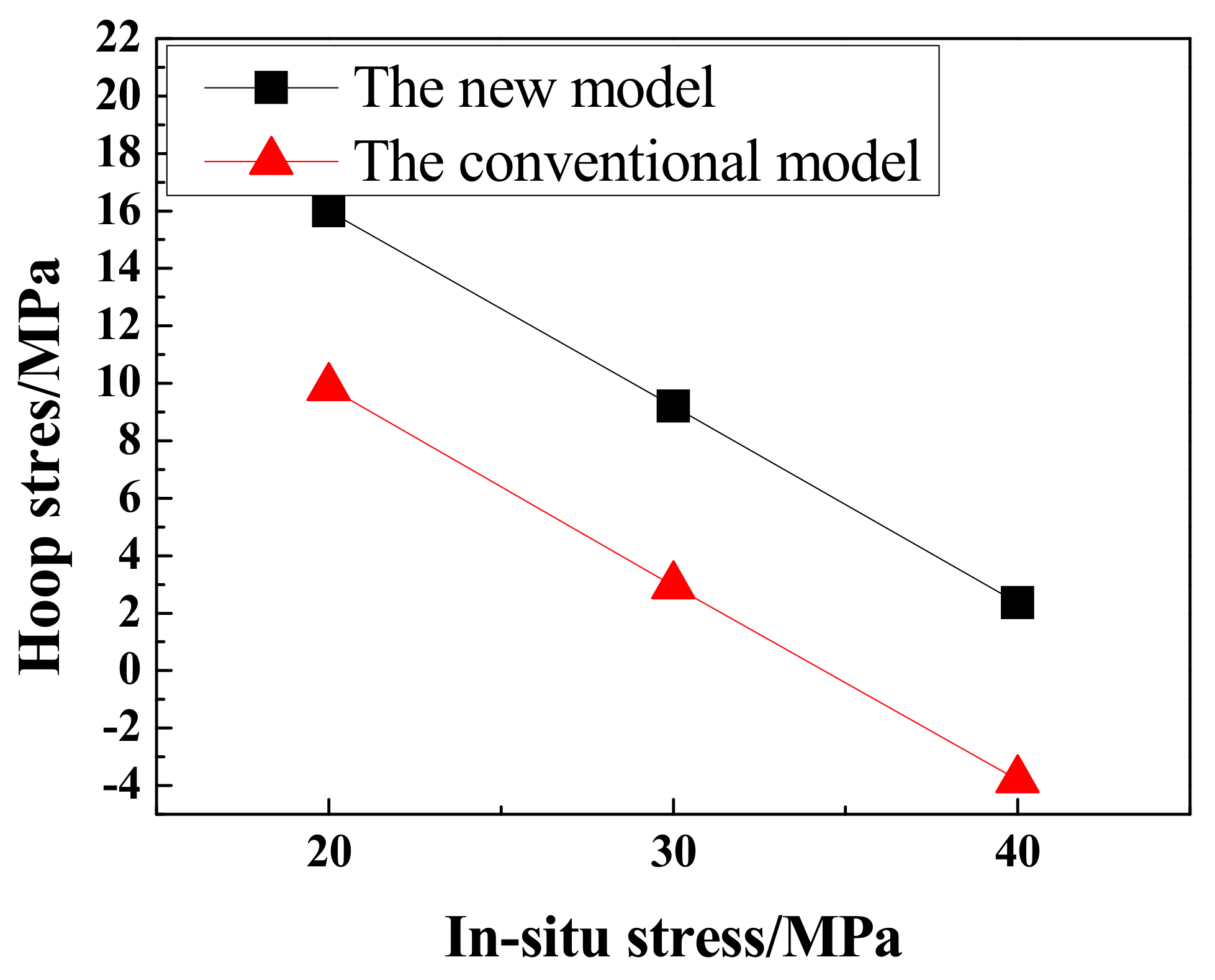
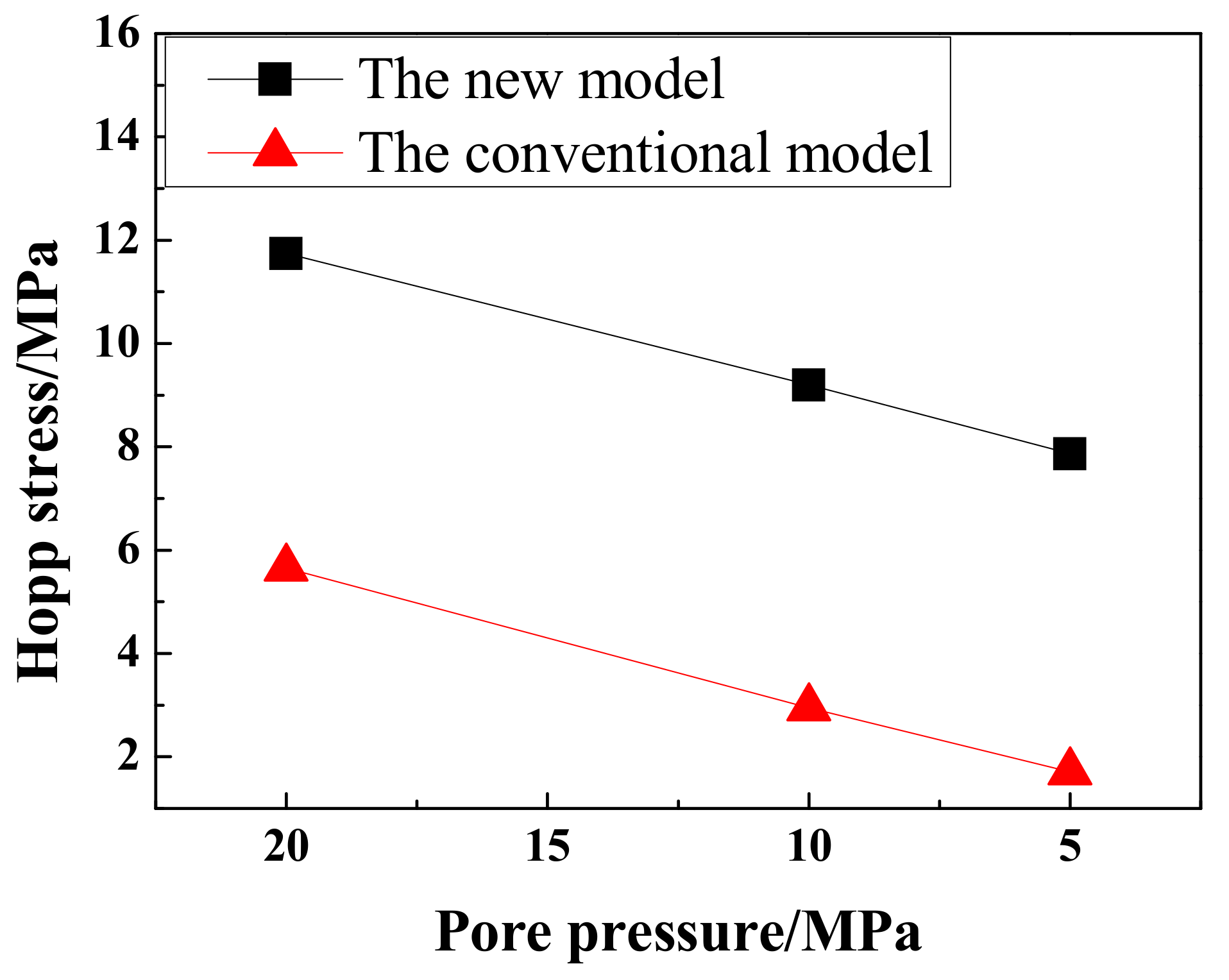

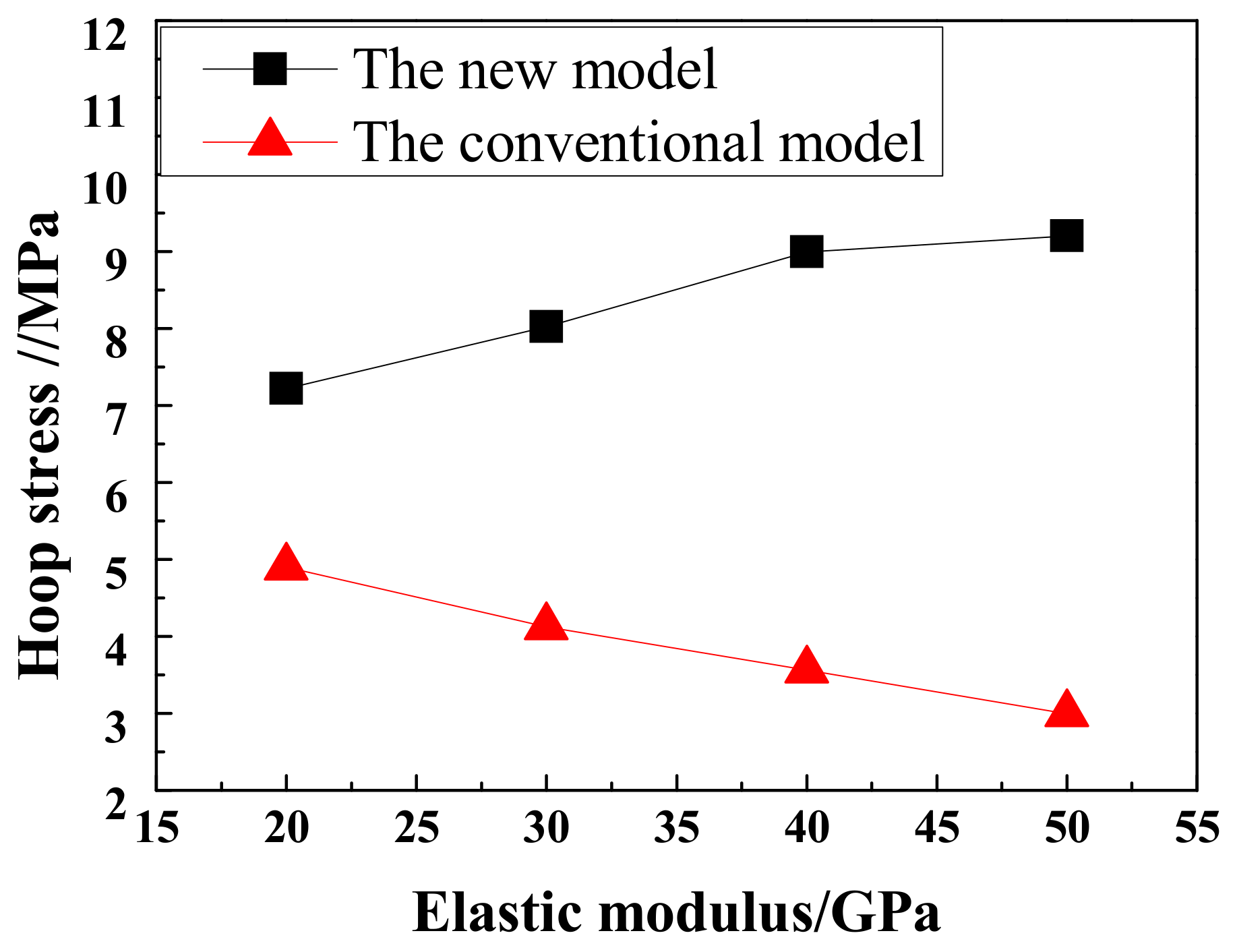
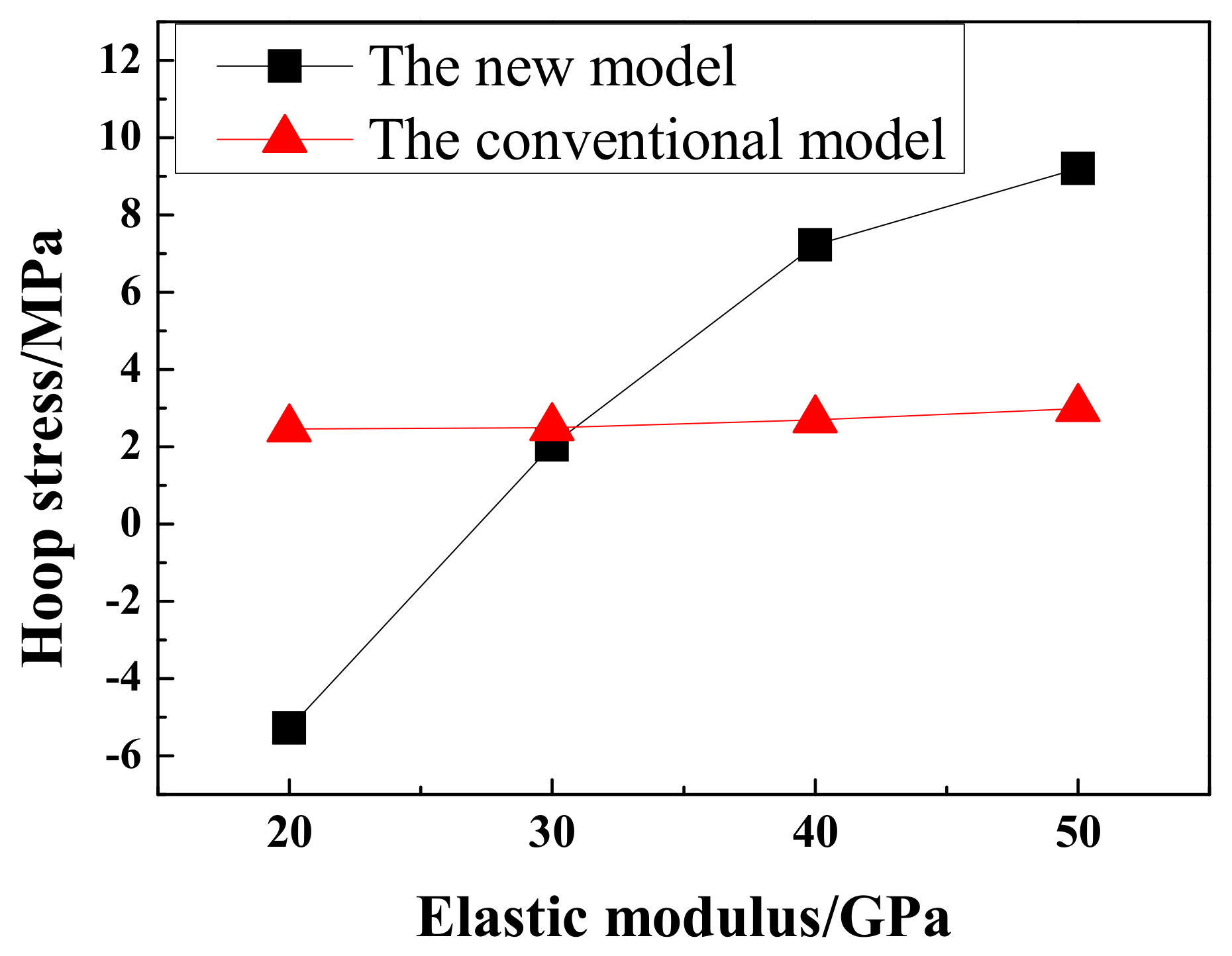
| Medium | OD/ | ID/ | Young’s Modulus/ | Poisson’s Ratio | Internal Friction Angle/° | Cohesion/ |
|---|---|---|---|---|---|---|
| Casing | 139.7 | 131.98 | 210 | 0.3 | - | - |
| Cement sheath | 215.9 | 139.7 | 9 | 0.15 | 17.1 | 21.6 |
| Formation | 1270 | - | : 20 : 17 | : 0.20 : 0.18 | 30 | 59.3 |
| Medium | Density/(kg·m−3) | Expansion Coefficient/°C−1 | Specific Heat Capacity/ | Thermal Conductivity Coefficient/ |
|---|---|---|---|---|
| Casing | 7800 | 1.22 × 10−5 | 460 | 45 |
| Cement sheath | 1800 | 1.05 × 10−5 | 865 | 0.9 |
| Formation | 2300 | 1.03 × 10−5 | 896 | 2.2 |
© 2018 by the authors. Licensee MDPI, Basel, Switzerland. This article is an open access article distributed under the terms and conditions of the Creative Commons Attribution (CC BY) license (http://creativecommons.org/licenses/by/4.0/).
Share and Cite
Fan, M.; Li, J.; Liu, G. New Method to Analyse the Cement Sheath Integrity During the Volume Fracturing of Shale Gas. Energies 2018, 11, 750. https://doi.org/10.3390/en11040750
Fan M, Li J, Liu G. New Method to Analyse the Cement Sheath Integrity During the Volume Fracturing of Shale Gas. Energies. 2018; 11(4):750. https://doi.org/10.3390/en11040750
Chicago/Turabian StyleFan, Mingtao, Jun Li, and Gonghui Liu. 2018. "New Method to Analyse the Cement Sheath Integrity During the Volume Fracturing of Shale Gas" Energies 11, no. 4: 750. https://doi.org/10.3390/en11040750




